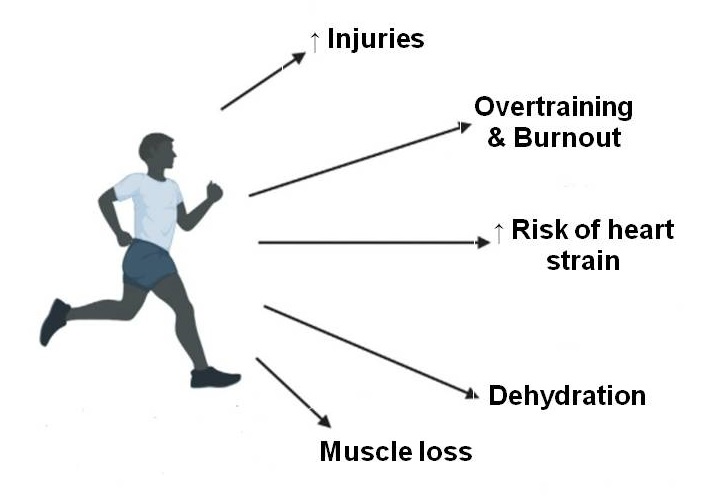Risks and Safe Practice Of HIIT
By Foluke Akinwalere. Freelance Health writer. Reviewed by: Oluwasola Samuel.

Image of an African bodybuilder. Image source: Freepik
High-intensity interval training (HIIT) is a workout method that involves short bursts of intense exercise followed by brief recovery periods. It can be as short as 10 to 30 minutes.
HIIT is an effective way to burn fat, boost endurance, and improve heart health. It is a powerful workout method that delivers fast and efficient fitness results. If done incorrectly, it can do more harm than good.
Many people, especially beginners, make common mistakes such as pushing too hard, neglecting proper recovery, skipping warm-ups, or using improper form, which can lead to injuries, fatigue, or even heart strain. Understanding these risks and learning how to avoid them can help you maximise the benefits of HIIT while staying safe.
Many people, especially beginners, make common mistakes like skipping warm-ups, pushing too hard, or neglecting proper form, which can negatively impact their health and fitness goals.
Potential risks of improper HIIT and how to avoid them
HIIT involves explosive, high-impact, and quick movements, which stress the muscles and joints. This results in injuries if not performed correctly. [1]
This can lead to common injuries such as:
Moreover, customising HIIT workouts based on your fitness levels can reduce the risk of injuries. [1]
2. Overtraining and Burnout
Some people believe that doing HIIT every day will speed up weight loss and fitness gains. The truth is, excessive HIIT can cause fatigue, burnout, and pain.

Risks of HIIT when done incorrectly
While HIIT is excellent for cardiovascular health, overdoing it can put too much stress on the heart, especially for people with pre-existing heart conditions.
Who should be cautious?
HIIT workouts cause intense sweating, which leads to loss of fluid and electrolytes. Drink the right amount of water to avoid muscle cramps, dizziness, or fatigue.
A useful suggestion is to drink a small quantity of water (150- 300mL) every 15 to 20 minutes during exercise, adjusting the amount based on how much you are sweating. Maintaining a fluid replacement rate that closely matches your sweat loss helps keep body temperature, heart rate, and effort level at their lowest levels. [2] Drink water before, during, and after HIIT exercises.
If HIIT is done without proper nutrition and recovery, it can lead to muscle breakdown.
HIIT offers incredible benefits, but it may not be suitable for everyone in the same way. Factors such as age, fitness level, pre-existing health conditions, and injury history all play a role in determining whether someone should do HIIT and how they should approach it.
Let’s explore who can safely do HIIT, who should be cautious, and what modifications can make HIIT workouts more accessible.
Yes! Beginners can do HIIT. However, they need to start at a manageable pace. It can be adapted to suit all fitness levels, including beginners. Jumping straight into an intense routine without proper preparation can lead to injury, burnout, or excessive fatigue.
Older adults can greatly benefit from HIIT, but caution is necessary. [3] As you age, muscle strength, joint flexibility, and cardiovascular endurance naturally decline. It is important to modify workouts as needed to suit your current fitness level to prevent strain or injury.
For individuals with chronic conditions like high blood pressure, diabetes, heart disease, asthma, or respiratory issues, HIIT can be beneficial if done correctly and under medical supervision. It is important to consult a doctor before starting any exercise and modify workouts to match your fitness level.
Health conditions and HIIT considerations:
Pregnant women can safely engage in exercise. A recent study found that HIIT was well tolerated by pregnant mothers and babies. [4] However, a doctor or prenatal fitness expert should be consulted before attempting any form of HIIT during pregnancy to avoid the risk of injury, dehydration, and overtiredness.
People recovering from injuries should approach HIIT with caution. While HIIT helps with strength and rehabilitation, doing the wrong movements can worsen injuries or delay recovery.
HIIT can be an excellent way to improve fitness, burn fat, and boost endurance—but only when done correctly. Avoiding common mistakes like skipping warm-ups, neglecting form, or overtraining can help prevent injuries and long-term health issues. If you are new to HIIT or have any health concerns, consult a fitness professional or doctor for guidance. Listen to your body, modify workouts when needed, and ensure proper recovery after each session to help you enjoy the full benefits of HIIT safely.
References
1. Plizga, Jakub & Jaworski, Arkadiusz & Grajnert, Filip & Gluszczyk, Agnieszka & Surma, Alicja & Cecot, Jakub & Parfianowicz, Agnieszka & Zarzecki, Konrad & Mandryk, Mi?osz & Holdun, Nazar. (2024). High-Intensity Interval Training - health benefits and risks - literature review. Quality in Sport. 18. 53359. 10.12775/QS.2024.18.53359. Available from here
2. Latzka WA, Montain SJ. Water and electrolyte requirements for exercise. Clin Sports Med. 1999 Jul;18(3):513-24. doi: 10.1016/s0278-5919(05)70165-4. PMID: 10410838.Available from here
3. Marriott CFS, Petrella AFM, Marriott ECS, Boa Sorte Silva NC, Petrella RJ. High-Intensity Interval Training in Older Adults: a Scoping Review. Sports Med Open. 2021 Jul 19;7(1):49. doi: 10.1186/s40798-021-00344-4. PMID: 34279765; PMCID: PMC8289951.Available from here
4. Wowdzia JB, Hazell TJ, Berg ERV, Labrecque L, Brassard P, Davenport MH. Maternal and Fetal Cardiovascular Responses to Acute High-Intensity Interval and Moderate-Intensity Continuous Training Exercise During Pregnancy: A Randomized Crossover Trial. Sports Med. 2023 Sep;53(9):1819-1833. doi: 10.1007/s40279-023-01858-5. Epub 2023 May 22. PMID: 37213048. Available from here
Related
High-Intensity Interval Training: A Better Fitness Approach for Africans
Weekend Exercising is as Beneficial for Health as Daily, Study Says
7 Tips for Sustainable Exercise for Beginners in Africa
Best Exercise for Healthy Ageing in Africans (Tips)
Exercising in Natural Surroundings More Beneficial Than Indoors, Study
Exercising When Sick: Good or Bad, and Safety Tips to Follow
8 Best Gym Hygiene Practices for Africans
Published: March 20, 2025
© 2025. Datelinehealth Africa Inc. All rights reserved.
Permission is given to copy, use and share content freely for non-commercial purposes without alteration or modification and subject to source attribution.
DATELINEHEALTH AFRICA INC., is a digital publisher for informational and educational purposes and does not offer personal medical care and advice. If you have a medical problem needing routine or emergency attention, call your doctor or local emergency services immediately, or visit the nearest emergency room or the nearest hospital. You should consult your professional healthcare provider before starting any nutrition, diet, exercise, fitness, medical or wellness program mentioned or referenced in the DatelinehealthAfrica website. Click here for more disclaimer notice.